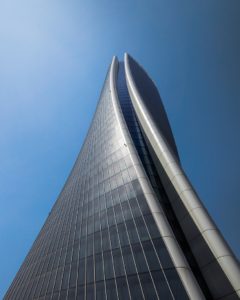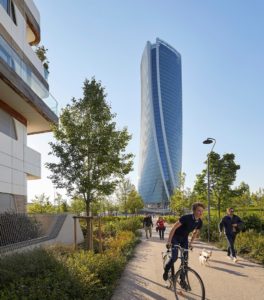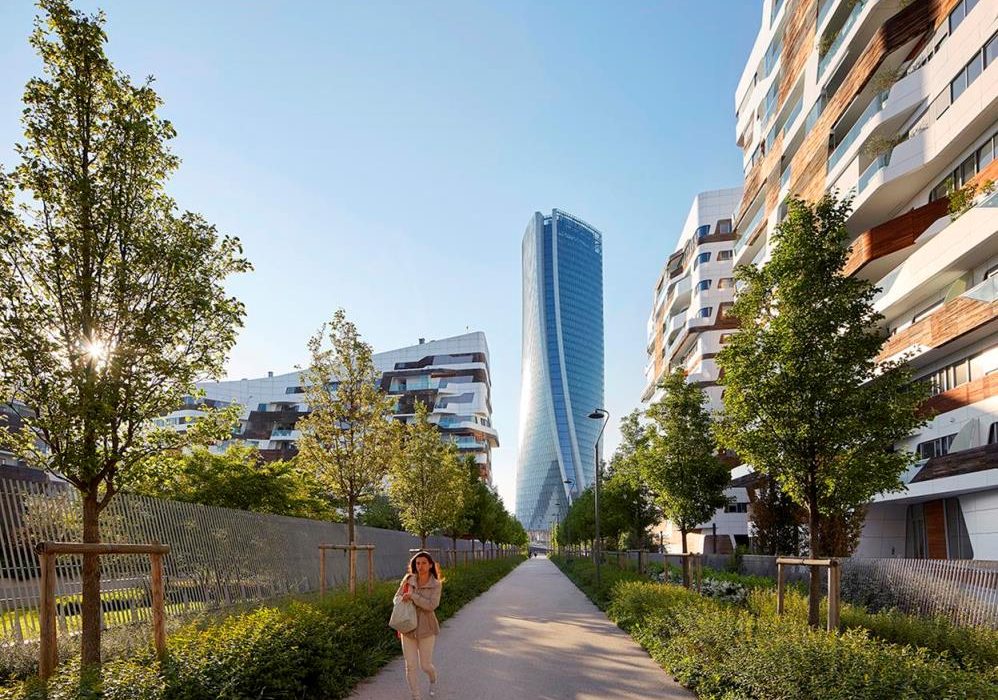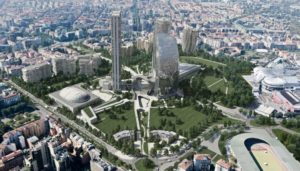In Milano, Italy, the 250-acre former fairgrounds of the Italian Expo are being redeveloped into a $3.2 billion mixed-use project called CityLife Milano.
It’s close to the historic city center, so it should help revitalize and green Milano’s office-intensive downtown. The trade fair grounds have been abandoned for over a decade, following the fair’s relocation to Rho Pero in 2005.
CityLife Milano will be the largest car-free area in all of Europe, featuring 168,000 square meters of parks and pedestrian/bicycle trails.
Located above the new Tre Torri station on Line 5 of the city’s metro system, CityLife opens the central 90-acre portion of the site to year-round public use for the first time; providing new civic spaces, public parks and residential areas, in addition to shopping districts and corporate offices.
When fully complete in 2020, CityLife will be the largest new civic space and public park created in the city since Parco Sempione opened 130 years ago. It’s expected to welcome over seven million visitors, workers and residents annually.
CityLife will include 1,000 new homes, offices for more than 11,000 staff, a new 42-acre public park, piazzas and kindergarten.
The redevelopment is being carried out by a company controlled by the Generali Group, which won the international tender for the redevelopment of the historic neighborhood of Fiera Milano with their offer of €523 million. The project is designed by the world-famous architects Zaha Hadid, Arata Isozaki and Daniel Libeskind.
 From a distance, the focal point of the project will be Generali Tower,
From a distance, the focal point of the project will be Generali Tower,
Aligned at ground level with three of the city’s primary axes that converge within CityLife, the 170 meter (44-story) Generali Tower connects with its surrounding public piazzas and park; the curvilinear geometries of its podium defined by the perceived centripetal forces generated from the staggered intersection of these three city axes at the tower’s base.
This vortex of centripetal forces at ground level is transferred vertically through the tower by realigning successive rhomboid-shaped floor plates to twist the tower about its vertical axis. This helical twist reduces incrementally with the height of each floor above street level, giving all floors a fractionally different relationship to the floors above and below.
As the tower rises offering broader views across Milan, the twist orientates the tower’s higher floors to the primary southeast axis leading to Bramante’s 15th Century tribune of Santa Maria della Grazie, and beyond to the centre of the city.
 With its interiors to be completed this summer, Generali Tower will house up to 3,900 employees to meet their continued growth as one of the world’s largest financial institutions.
With its interiors to be completed this summer, Generali Tower will house up to 3,900 employees to meet their continued growth as one of the world’s largest financial institutions.
The tower excels in all international benchmarks for efficiency while respecting Milan’s rigorous local building codes. Its double-façade of sun-deflecting louvers flanked by glazing provides extremely efficient environmental control for each floor and ensures excellent energy performance, contributing to Generali Tower’s LEED Platinum certification by the US Green Building Council.
Inclined perimeter columns follow the twisting geometry of the tower to mirror the inclined alignment of its external façade units. These perimeter columns also maximise usable office space within the tower’s coherent formal envelope.
An integral element of the CityLife redevelopment that has created a new civic, residential and business district near the centre of Milan, Generali Tower is defined by its surrounding urban fabric to connect directly with the city.
All images courtesy of Zaha Hadid Architects unless otherwise credited.


